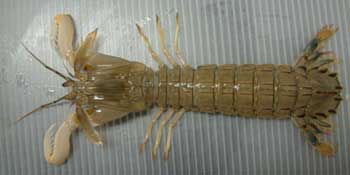Sakura Ebi: Autumn Catch
November 5th saw the first haul of Sakura ebi/Cherry blossom Shrimp of the Autumn being auctioned at Yui Harbour and Oikawa Fish Market.
12 tonnes were sold, that is about three times as much as last year.
Stocks have been plentiful thanks to very strict enforcement of catch limits self-imposed by the Sakura Ebi Fishermen Association, the first-ever such association in the whole of Japan to impose such voluntary limits of their catches!
Sakura Ebi are exclusively caught in the middle of Suruga Bay.
They are sucked into the boats directly from the nets, ensuring a later release of all unwanted catch live and unharmed into the sea.
Who said the Japanese were depopulating the sea?
——————————–
Shiroebi/White Shrimp
Shiroebi or White Shrimp is not as known as other shrimp/prawn varieties. However it is a very popular crustacean in Japanese cuisine.
Also known under the the names of “Shiraebi, Hirataebi and Bekkoebi”, it is mainly caught between depths of 40 and 200 metres off the coasts of Toyama Bay on the other side of Japan and Suruga Bay in Shizuoka Prefecture.

It is mainlly served a sashimi with some ponzu and grated fresh ginger

as “gunkan” topped with a dash of grated fresh ginger.
It is possible to serve it as “nigiri”, although one would need large specimen, as the usual length is only 7 cm.
We are just in season as Shiroebi appears on our tables between April and November in many guises:

The picture above shows on the right the shiroebi in its natural flesh whereas on the left it has been kept between two sheets of wetted seaweed for a while as “kombu-jime”, another very popular way to prepare all kinds of sashimi/sushi.
White Shrimps also enter in the preparation of a kind of “Tamagoyaki”/Japanese Omelette when they are first processed into a paste and mixed thoroughly with beaten eggs, sieved and then cooked.
The Japanese also love them as soft sembei/rice crckers.
The annual catch has exceeded 600 tonnes in recent years, half of them in Toyama.
They are also exported whole.
————————
Botanebi/Botan Prawn

Botanebi/”Botan” Prawn, or “Pandalus nipponesis” for the specialists, is a large prawn found in all seas of Japan at depths varying from 300 to 500 metres. They are caught at 200~300 metres depth in Suruga Bay and along the WEstern coast of Izu Peninsula In Shizuoka Prefecture. Once abundant, they have become scarce and only small specimen are found whereas Hokkaido produces up to 20cm-long prawns.

They are known under different names: toyamaebi and Kijiebi.
It is not a cheap morsel in Sushi bars. But it is interesting to note they are essentially eaten raw as like “amaebi”, they become very sweet after some time in the refrigerator.

Now, if you are lucky enough to find them fresh with their eggs, ask your chef to dress them as above, or even better, put the eggs on top of a “gunakan nigiri”!
Incidentally, botanebi change sex (gender) with age to end up as big juicy females!
—————————
Squilla/Shako
The Squilla or “Shako” is a delicacy that appears on the sushi bar counters from April to Summer, although different varieties can be found in Hokkaido markets (Otaru City in particular) almost all year round.
You will discover under names such as “shaku” and “Gazaebi”.
They are actually caught in almost all Japanese seas, but the best are supposed to originate from Hokkaido.

Like any crustaceans, they can be eaten in many ways.
The Japanese favour the small kind with a violet back. I have had to buy some very large specimen in Otaru, and just boiled to eat them with rice vinegar mixed a little Japanese mustard or in salad.
They almost disappeared from Tokyo Bay in the 1960’s but reappeared in the 1970’s. Most fishermen in the Kanto area will place them in boxes themselves to sell them directly at fish markets. The market value can vary wildly, but look for the genuine harbour markets and buy them yourself.

Naturally, they are most popular as nigiri sushi. Customers jokingly ask for “garage” (in English) as “shako” also means (different kanji, of course) “garage”!


